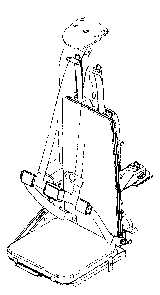Some of the information on this Web page has been provided by external sources. The Government of Canada is not responsible for the accuracy, reliability or currency of the information supplied by external sources. Users wishing to rely upon this information should consult directly with the source of the information. Content provided by external sources is not subject to official languages, privacy and accessibility requirements.
Any discrepancies in the text and image of the Claims and Abstract are due to differing posting times. Text of the Claims and Abstract are posted:
| (12) Patent Application: | (11) CA 2706298 |
|---|---|
| (54) English Title: | IMPROVED VEHICLE SEAT |
| (54) French Title: | SIEGE DE VEHICULE AMELIORE |
| Status: | Deemed Abandoned and Beyond the Period of Reinstatement - Pending Response to Notice of Disregarded Communication |
| (51) International Patent Classification (IPC): |
|
|---|---|
| (72) Inventors : |
|
| (73) Owners : |
|
| (71) Applicants : |
|
| (74) Agent: | GOWLING WLG (CANADA) LLP |
| (74) Associate agent: | |
| (45) Issued: | |
| (22) Filed Date: | 2010-06-01 |
| (41) Open to Public Inspection: | 2011-12-01 |
| Availability of licence: | N/A |
| Dedicated to the Public: | N/A |
| (25) Language of filing: | English |
| Patent Cooperation Treaty (PCT): | No |
|---|
| (30) Application Priority Data: | None |
|---|
This invention relates to a system and method of armed forces vehicle seating
which
reduces the potential for injury to occupants when the vehicle is subjected to
a landmine
or similar explosive device. The seats are floor, ceiling or wall mounted and
include a
trailer arm which allows deflection while providing stability. This
arrangement isolates
the occupants from the chassis of the vehicle via a pneumatic or other shock
absorber.
These seats can also be combined with shock absorbing/isolating foot rests,
appendage
(leg) restrain systems and an occupant four-point harness to offer a
completely
integrated system. This integrated system reduces acceleration/deceleration
related
injuries, shock injuries to the lower legs, flailing injuries to the lower
legs and internal
collision injuries. Other options and alternatives are also described.
Note: Claims are shown in the official language in which they were submitted.
Note: Descriptions are shown in the official language in which they were submitted.

2024-08-01:As part of the Next Generation Patents (NGP) transition, the Canadian Patents Database (CPD) now contains a more detailed Event History, which replicates the Event Log of our new back-office solution.
Please note that "Inactive:" events refers to events no longer in use in our new back-office solution.
For a clearer understanding of the status of the application/patent presented on this page, the site Disclaimer , as well as the definitions for Patent , Event History , Maintenance Fee and Payment History should be consulted.
| Description | Date |
|---|---|
| Inactive: Dead - RFE never made | 2016-06-01 |
| Application Not Reinstated by Deadline | 2016-06-01 |
| Inactive: Abandon-RFE+Late fee unpaid-Correspondence sent | 2015-06-01 |
| Inactive: Office letter | 2015-02-12 |
| Letter Sent | 2014-05-15 |
| Reinstatement Requirements Deemed Compliant for All Abandonment Reasons | 2014-05-14 |
| Letter Sent | 2014-01-17 |
| Letter Sent | 2013-11-06 |
| Letter Sent | 2013-11-06 |
| Letter Sent | 2013-11-06 |
| Deemed Abandoned - Failure to Respond to Maintenance Fee Notice | 2013-06-03 |
| Application Published (Open to Public Inspection) | 2011-12-01 |
| Inactive: Cover page published | 2011-11-30 |
| Inactive: Reply to s.37 Rules - Non-PCT | 2011-09-01 |
| Inactive: Correspondence - Formalities | 2011-09-01 |
| Inactive: IPC assigned | 2011-07-20 |
| Inactive: IPC assigned | 2011-07-20 |
| Inactive: Filing certificate - No RFE (English) | 2010-10-28 |
| Filing Requirements Determined Compliant | 2010-10-28 |
| Inactive: IPC assigned | 2010-09-15 |
| Inactive: First IPC assigned | 2010-09-15 |
| Inactive: IPC assigned | 2010-09-15 |
| Application Received - Regular National | 2010-07-08 |
| Abandonment Date | Reason | Reinstatement Date |
|---|---|---|
| 2013-06-03 |
The last payment was received on 2015-05-22
Note : If the full payment has not been received on or before the date indicated, a further fee may be required which may be one of the following
Please refer to the CIPO Patent Fees web page to see all current fee amounts.
| Fee Type | Anniversary Year | Due Date | Paid Date |
|---|---|---|---|
| Application fee - standard | 2010-06-01 | ||
| MF (application, 2nd anniv.) - standard | 02 | 2012-06-01 | 2012-04-05 |
| Registration of a document | 2013-10-18 | ||
| Registration of a document | 2013-12-06 | ||
| Reinstatement | 2014-05-14 | ||
| MF (application, 3rd anniv.) - standard | 03 | 2013-06-03 | 2014-05-14 |
| MF (application, 4th anniv.) - standard | 04 | 2014-06-02 | 2014-05-14 |
| MF (application, 5th anniv.) - standard | 05 | 2015-06-01 | 2015-05-22 |
Note: Records showing the ownership history in alphabetical order.
| Current Owners on Record |
|---|
| MED-ENG, LLC |
| Past Owners on Record |
|---|
| NEIL GRANT |